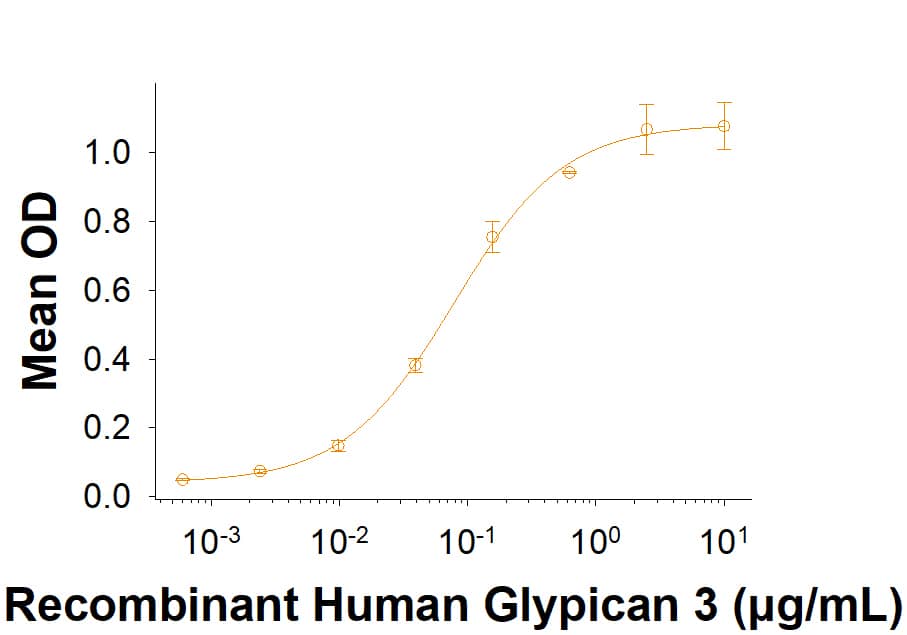Recombinant Human Glypican 3 Fc Chimera Protein, CF
R&D Systems, part of Bio-Techne | Catalog # 11078-GP

Key Product Details
Source
HEK293
Accession #
Structure / Form
Disulfide-linked homodimer. Glypican 3 is subject to endoproteolytic processing by proprotein convertases (PC). By amino acid sequencing, Two subunits (Alpha and Beta) are present (Alpha inferred to start with Gln25 and Beta starting with Ser359). They are associated via disulfide bonds.
Conjugate
Unconjugated
Applications
Bioactivity
Product Specifications
Source
Human embryonic kidney cell, HEK293-derived human Glypican 3 protein
| Human Glypican 3 (Gln25-His559) Accession # P51654.1 |
IEGRMD | Human IgG1 (Pro100-Lys330) |
| N-terminus | C-terminus |
Purity
>90%, by SDS-PAGE visualized with Silver Staining and quantitative densitometry by Coomassie® Blue Staining.
Endotoxin Level
<1.0 EU per 1 μg of the protein by the LAL method.
N-terminal Sequence Analysis
No results obtained. Gln25
inferred from enzymatic pyroglutamate treatment revealing Pro26 and Ser359.
Predicted Molecular Mass
87 kDa (monomer)
SDS-PAGE
230-330 kDa, under non-reducing conditions.
Activity
Measured by its binding ability in a functional ELISA.
When Recombinant Human FGF basic/FGF2/bFGF (Catalog # 233-FB/CF) is immobilized at 0.500 µg/mL (100 µL/well), Recombinant Human Glypican 3 Fc Chimera Protein binds with an ED50 of 0.0120-0.120 µg/mL.
When Recombinant Human FGF basic/FGF2/bFGF (Catalog # 233-FB/CF) is immobilized at 0.500 µg/mL (100 µL/well), Recombinant Human Glypican 3 Fc Chimera Protein binds with an ED50 of 0.0120-0.120 µg/mL.
Scientific Data Images for Recombinant Human Glypican 3 Fc Chimera Protein, CF
Recombinant Human Glypican 3 Fc Chimera Protein Binding Activity.
When Recombinant Human FGF basic/FGF2/bFGF (233-FB) is immobilized at 0.500 µg/mL (100 µL/well), Recombinant Human Glypican 3 Fc Chimera Protein (Catalog # 11078-GP) binds with an ED50 of 0.0120-0.120 µg/mL.Formulation, Preparation and Storage
11078-GP
| Formulation | Lyophilized from a 0.2 μm filtered solution in PBS. |
| Reconstitution | Reconstitute at 500 μg/mL in PBS. |
| Shipping | The product is shipped at ambient temperature. Upon receipt, store it immediately at the temperature recommended below. |
| Stability & Storage | Use a manual defrost freezer and avoid repeated freeze-thaw cycles.
|
Background: Glypican 3
References
- Ho, M. and Kim, H. (2012) Eur. J. Cancer. 47:333.
- Haruyama, Y. and Kataoka, H. (2016) World J. Gastroenterol. 22:275.
- Shimizu, Y. et al. (2019) Front Oncol. 9:248.
- Gonzales, A.D. et al. (1998) J. Cell Biol. 141:1407.
- Xue, Y. et al. (2018) Am J Pathol. 188(6):1469.
- Ge, S. et al. (2018) Filmus, Int J Clin Exp Pathol. 11(12):5774.
- Pilia, G. et al. (1996) Nature Genet.12:241.
Alternate Names
GPC3
Gene Symbol
GPC3
UniProt
Additional Glypican 3 Products
Product Documents for Recombinant Human Glypican 3 Fc Chimera Protein, CF
Product Specific Notices for Recombinant Human Glypican 3 Fc Chimera Protein, CF
For research use only
